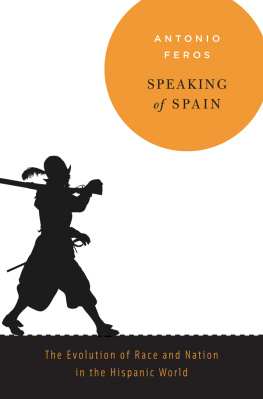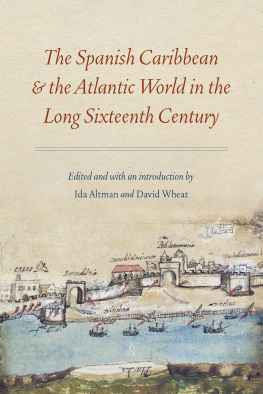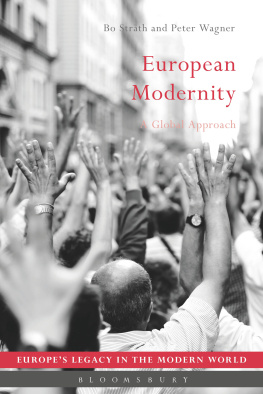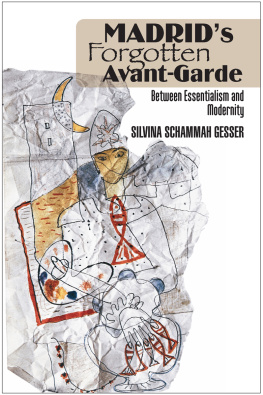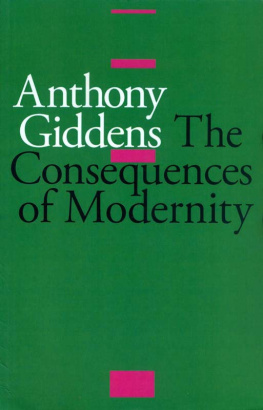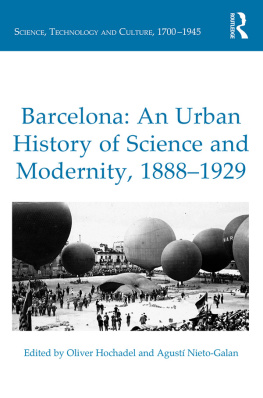Visualizing Spanish Modernity
Visualizing Spanish Modernity
Edited by
SusanLarsonandEvaWoods
First published 2005 by Berg Publishers
Published 2020 by Routledge
2 Park Square, Milton Park, Abingdon, Oxon OX14 4RN
605 Third Avenue, New York, NY 10017
Routledge is an imprint of the Taylor & Francis Group, an informa business
Copyright Susan Larson and Eva Woods 2005
All rights reserved. No part of this book may be reprinted or reproduced or utilised in any form or by any electronic, mechanical, or other means, now known or hereafter invented, including photocopying and recording, or in any information storage or retrieval system, without permission in writing from the publishers.
Notice:
Product or corporate names may be trademarks or registered trademarks, and are used only for identification and explanation without intent to infringe.
Library of Congress Cataloging-in-Publication Data
Visualizing Spanish modernity / edited by Susan Larson and Eva Woods. English ed.
p. cm.
Includes bibliographical references and index.
ISBN 1-85973-801-X (cloth) ISBN 1-85973-806-0 (pbk.)
1. Popular cultureSpainHistory19th century. 2. Visual communication
SpainHistory19th century. 3. SpainIntellectual life19th century. 4. Popular
cultureSpainHistory20th century. 5. Visual communicationSpainHistory
20th century. 6. SpainIntellectual life20th century. 7. SpainIn art. I. Larson,
Susan, 1968- II. Woods, Eva.
DP203.5.V58 2005
306'.0946'09034dc22 2005017026
British Library Cataloguing-in-Publication Data
A catalogue record for this book is available from the British Library.
ISBN13; 978-1-8597-3801-6 (hbk)
Typeset by Avocet Typeset, Chilton, Aylesbury, Bucks
For Marc and Oscar
For Jesse
Visualizing Spanish Modernity is the product of several years of collaboration with friends and colleagues. It has taken many turns in its trajectory from the abstract to the real and has been made possible because of generous grants from several institutions. We received essential publication and permissions subsidies through the Research Committee at Vassar College and were awarded a grant from the University of Minnesota's Program for Cultural Cooperation Between Spain's Ministry of Education, Culture and Sports and United States Universities. We will always be grateful to Malcolm A. Compitello and Arnaldo Cruz-Malave for their assistance in securing this aid even before the collection had taken shape. David Bird lent a helping hand at a critical time with the permissions. We are also indebted to L. Elena Delgado, Jordana Mendeison and Oscar E. Vazquez, the organizers of the Recalcitrant Modernities: Spain, Difference and the Construction of European Modernism conference at the University of Illinois in Urbana-Champaign for inviting us to share an early version of our introduction with an exceptionally creative and supportive group of established interdisciplinary scholars.
We would like to thank Enrique Blanco Arroyo and Josefira Martinez for the cover image and their solidarity with our project. Jane Livingston of Vassar's Computer Instructional Services provided the essential technical know-how to create the cover, and lan Critchley from the Production Department at Berg guided us through the artistic decisions. Kathleen May and Francesca Martin, also at Berg, were consistently supportive and encouraging editors. We feel very fortunate to have worked with them. We received invaluable advice from Andrew Bush, Lisa Paravisini, Jeffrey Schneider, and Sherry Velasco. Many thanks also go to those who read portions of the manuscript: Lou Charnon-Deutsch, Dianna Niebylski, Ana Rueda, and especially William F. Woods. Thanks to Gabe Milner for his translation
Most of all, we take this opportunity to thank all of the contributors who have entrusted their work to us and given us the incredibly stimulating experience of theorizing Spain's modern period through the lens of visual studies. The frequent contact we had with the authors of the chapters included here immersed us for a time in a provisional, virtual scholarly community that we will genuinely miss.
Andrew Bush is Professor of Hispanic Studies and Jewish Studies at Vassar College, Poughkeepsie, New York. He has published widely in both fields, and served as the editor of the de Estudios Hispanicos. Most recently he has written essays on American Jewish poetry, the philosophy of Maria Zambrano, and Golden Age drama. He is also the author of The Routes of Modernity: Spanish American Poetry from the Early Eighteenth to the Mid-Nineteenth Century (Bucknell UP, 2000).
Lou Charnon-Deutsch is Professor of Spanish and Women's Studies at State University of New York Stony Brook. Her recent books include Narratives of Desire: Nineteenth-Century Spanish Fiction by Women (Pennsylvania State UP, 1994), Culture and Gender in Nineteenth-Century Spain (co-edited with Jo Labanyi: Oxford UP, 1995), Fictions of the Feminine in the Nineteenth-Century Spanish Press (Pennsylvania State UP, 2000), and The Spanish Gypsy: History of a European Obsession (Pennsylvania State UP 2004). She serves on the editorial board of the Revista de Estudios Hispnicos, Decimonnica, and Letras Femeninas and is American Editor of The Hispanic Research Journal.
ElenaCueto Asn is Assistant Professor of Spanish at Bowdoin College, Maine. Her field of research includes the relationships between literature and the visual arts in Spain, especially in the area of theater, as well as the connections between Spanish and French cultural production. Her work appears in various journals including ALEC, Catalan Review, Revista de Estudios Hispnicos, and Romance Language Annual.
RobertA. Davidson is Assistant Professor of Spanish at the University of Toronto. He works on the avant-garde, architecture, and cinema and is currently preparing two books: Jazz Age Barcelona: Text, Rhythm and Violence as well as a second project that deals with the space of the modern hotel. He is co-editor of "New Coordinates: Spatial Mappings, National Trajectories," a forthcoming double issue of Diacritics and is Book Review Editor for the Revista Canadiense de Estudios Hispnicos.
Brad Epps is Professor of Romance Languages and Literatures and Studies in Women, Gender, and Sexuality at Harvard University. He has published over fifty articles on modern literature, film, art, architecture, and immigration from Spain, Latin America, Catalonia, and France and is the author of Significant Violence: Oppression and Resistance in the Narratives of Juan Goytisoio (Oxford UP, 1996). He is currently preparing two books: Daring to Write, on gay and lesbian issues in Latin America, Spain, and Latino cultures in the United States, and Barcelona and Beyond, on the transformations of the Catalan capital. He is also co-editing two volumes, one with Luis Fernandez Cifuentes, Spain Beyond Spain: Modernity, Literary History, and National Identity, and another with Keja Valens, Passing Lines: Immigration and (Homo)sexuality.


